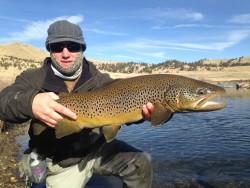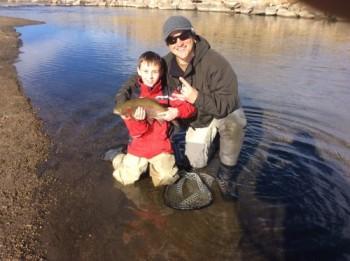Zack Tokach Student of the Game
With his arm up over the table at the restaurant, wrist at an angle as he pictures the drift, Zack Tokach, guide at Angler’s Covey, hook sets with his envisioned rod. As we talk, I get the impression that Zack is right there, on the river, reading the water, seeing the fish, as he explains the joys and challenges of fly fishing in general, and guiding, in particular.
Zack is a student of the game, a life long learner of his craft. If he’s not guiding, he’s probably fishing. If he’s not fishing or guiding, he’s probably at the vise tying flies. Maybe he’ll be on his dirt bike exploring the hills – but even then he’s probably thinking about fishing. “This never gets old – not guiding and not fly fishing,” he says.
 Last weekend, Zack (along with his buddy and fellow guide, Justin Brenner) led a class about chasing and finding large fish, the hawgs, that you can find on the Dream Stream, on the Taylor, or in Cheesman Canyon. He likes the pursuit and the challenge of getting big fish. The stealth required, the technique to trick big fish in our tailwaters (“this isn’t their first rodeo”), and the thrill when a fish is on. But then you hear him talk about fishing Spinney Res and finding fish there: “the best fight – they have so much water to run in, they can take you to your backing pretty fast.” Or he talks about pursuing brookies in small streams. He sees the challenge and the reward in each environment. And he wants his clients to feel the same.
Last weekend, Zack (along with his buddy and fellow guide, Justin Brenner) led a class about chasing and finding large fish, the hawgs, that you can find on the Dream Stream, on the Taylor, or in Cheesman Canyon. He likes the pursuit and the challenge of getting big fish. The stealth required, the technique to trick big fish in our tailwaters (“this isn’t their first rodeo”), and the thrill when a fish is on. But then you hear him talk about fishing Spinney Res and finding fish there: “the best fight – they have so much water to run in, they can take you to your backing pretty fast.” Or he talks about pursuing brookies in small streams. He sees the challenge and the reward in each environment. And he wants his clients to feel the same.
Guiding is coaching. “You take pleasure in the other guy’s success. That’s the excitement for a guide. Being happy for them when everything comes together.” Zack says guides have to be flexible – “you respond to the client’s goals.” If they have some experience and want to go after the big boys, if they want to learn stillwater, if a group of new anglers wants to get on fish and learn the adventure, the guide tailors the trip to meet their desires. Good guides know a lot of the different disciplines that make up fly fishing: throwing spinners, nymphing, drifting dry flies, Czech nymphing. A guide responds to the conditions and to the client’s skill set to make the outing successful and enjoyable for them.
That’s why you will find Zack out on the water exploring new stretches at Deckers or fishing new areas on Spinney throughout the season. A student of the game. He does his homework and pushes the boundaries.
 Zack was fishing Spinney Res and saw that fish were taking a small snail in the water. He scooped some up in his net and studied the size, shape, and body structure of the snail. Then he went to his tying table. After some experimentation with materials, the right size and shape hook, and several attempts to get it all layered correctly, he finally produced an effective imitation of the snail. Innovation.
Zack was fishing Spinney Res and saw that fish were taking a small snail in the water. He scooped some up in his net and studied the size, shape, and body structure of the snail. Then he went to his tying table. After some experimentation with materials, the right size and shape hook, and several attempts to get it all layered correctly, he finally produced an effective imitation of the snail. Innovation.
As we head deeper into fall fishing, Zack offered this tip for anglers: be patient and be prepared to move and cover more water. Sometimes anglers get locked into a routine. They head to a spot where they have had luck before only to find anglers already there or the spot just isn’t holding fish. Move. Try some new water. 200 yards in either direction of your “favorite hole” could be the spot.
The best guides are the ones that stay students of the sport. Honing their skills. Innovating. Building relationships with their clients for an enjoyable day on the river. Zack Tokach, you can see it in his eyes across the table as he watches, in his mind, the rise and the take.
